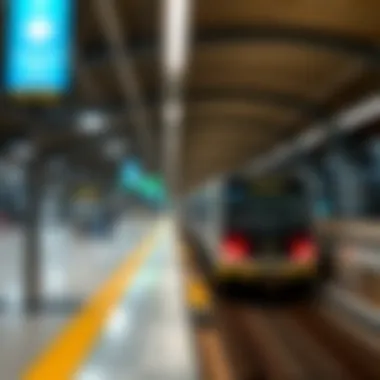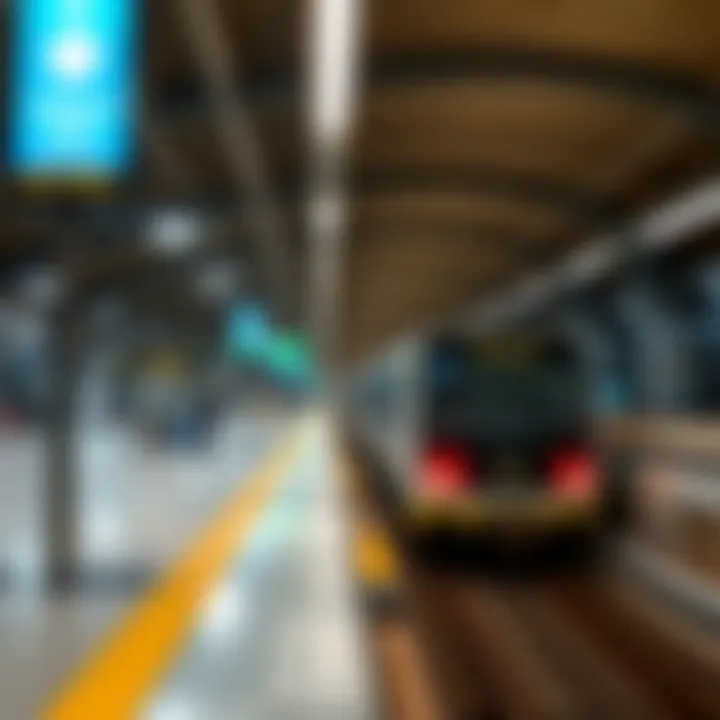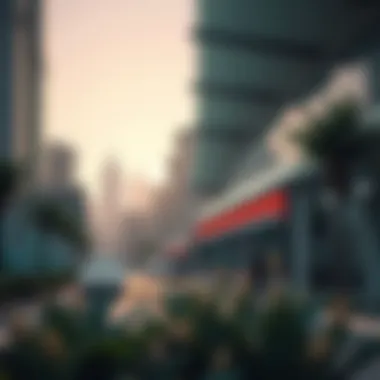Al Garhoud Metro Station: Key Link in Dubai's Transit System


Intro
In the heart of Dubai's bustling urban landscape lies Al Garhoud Metro Station, a pivotal piece in the intricate puzzle of the city’s transport network. Serving as a bridge between vibrant neighborhoods, this station not only enhances mobility but also transforms the real estate scene around it. As the city expands, understanding the significance of such transit nodes becomes essential for investors, residents, and urban planners alike.
This article will delve into various aspects of Al Garhoud Metro Station, examining its architectural design, the role it plays within the broader Dubai Metro system, and its influence on local community dynamics. In a time where rapid urbanization is reshaping cities worldwide, Al Garhoud stands out as a case study in effective public transport integration.
We’ll explore:
- The historical context that led to the station’s development
- Current market trends observable around the station
- Economic factors that sway local real estate
- Investment strategies relevant to prospective buyers
By synthesizing these threads, we aim to provide a holistic view of Al Garhoud Metro Station’s impact, helping stakeholders navigate the evolving landscape of Dubai’s transit-oriented developments.
Preamble to Al Garhoud Metro Station
Al Garhoud Metro Station is not just a blip on the transit map of Dubai; it represents a significant stride in the evolution of urban transport within the emirate. Greater than the mere convenience of hops and skips, this station acts as a vital junction that interlinks various neighborhoods and enhances overall accessibility across the sprawling cityscape.
Situated along the Red Line, Al Garhoud serves both residents and tourists, making it a critical stop for anyone looking to explore the vibrant landscape of Dubai. From the cultural allure of Al Garhoud's heritage sites to the bustling commercial activities, this station embodies the pulse of the community.
Key Benefits:
- Ease of Access: The station connects directly to multiple public transport lines, drastically reducing travel time across key areas.
- Community Integration: It fosters better connectivity between residential zones, businesses, and recreational facilities, enriching the everyday experiences of commuters.
- Real Estate Value: Its presence has implications for property markets, with nearby developments receiving heightened interest from investors, as proximity to viable transport options often elevates property values.
Furthermore, the implications of Al Garhoud Metro Station extend beyond mere convenience. It represents a commitment to sustainable transport solutions in a rapidly urbanizing region, showcasing how infrastructure developments can promote both economic growth and improved living standards. As urban planners and real estate investors look to align their strategies with evolving transportation trends, understanding the significance of Al Garhoud Metro Station becomes increasingly essential.
Historical Context of Metro Development in Dubai
The historical context of metro development in Dubai provides critical insights into the city's ambitious growth and transformation. Understanding this backdrop is essential for grasping how locations like Al Garhoud Metro Station fit into the larger puzzle of urban mobility in the emirate. Dubai's evolution from a modest trading post to a global metropolis reflects a vision that prioritized not just economic growth, but also efficient public transport to accommodate an ever-increasing population.
Evolution of Public Transport in Dubai
Over the past few decades, Dubai has experienced a remarkable journey in public transport, transitioning from a reliance on taxis and private vehicles to the introduction of extensive public transit systems.
Before the metro, the mainstay of urban mobility hinged on taxis and buses—while reliable, this method struggled to meet the demands of a rapidly expanding populace. The introduction of the metro was not merely an add-on; it signified a paradigm shift aimed at easing congestion and reducing travel time. The public transportation evolution started with simple bus routes, which laid the groundwork for more sophisticated systems.
Key Milestones in Metro Growth
- 1995: Strategy formed for a unified public transport system.
- 2005: Official announcement for the Dubai Metro project.
- 2009: Launch of the red line, marking the metro’s operational debut.
This evolution has been crucial in shaping the public's perception of mass transportation as a viable option. As the metro expanded, it not only catered to commuters but also stimulated economic activity across various sectors.
Foundation of Dubai Metro
The foundation of Dubai Metro represents Dubai's commitment to operational excellence and sustainability. Spearheaded by the Roads and Transport Authority (RTA), this project broke ground with visions of a modern transport backbone that would integrate seamlessly into daily life.
The metro's construction was a rigorous endeavor, involving various technologies and engineering feats. It aimed to significantly reduce the number of vehicles on the roads and combat the notorious traffic jams that plagued the city's roadways. Components of innovative design were pivotal in this project, emphasizing efficiency and user experience from its inception.
“The Dubai Metro was designed to ultimately serve approximately 1.6 million passengers daily, a bold target reflecting the city’s audacious ambitions.”
The project not only addressed immediate transportation demands but gave rise to a host of ancillary industries: construction, technology, and service. As a focus point, Al Garhoud Metro Station stands at the heart of this train of development, bridging communities and enhancing accessibility.
Architectural Design of Al Garhoud Station
The architectural design of Al Garhoud Metro Station is not just about visual appeal; it serves multiple purposes that impact the functionality, aesthetics, and user experience of the facility. In a city that prides itself on cutting-edge architecture, Al Garhoud stands out as a significant embodiment of form meeting function. The design elements carefully blend to enhance the overall accessibility and integrate seamlessly into the urban landscape.
Station Structure and Aesthetics
The station exhibits a striking modernist structure, characterized by clean lines and large glass panels. This design choice allows for natural light to illuminate the station, creating a bright and welcoming environment for daily commuters. This not only contributes to energy efficiency but also enhances the overall user experience, making the waiting areas feel less claustrophobic.


The roof of the station is another aspect worth mentioning; it features a unique geometric design that reflects the dynamic nature of Dubai's skyline. The use of high-quality materials ensures durability while also maintaining a sophisticated aesthetic.
Moreover, integrating wide platforms aids in efficient crowd management, especially during peak hours when foot traffic increases.
- Key structural elements include:
- Spacious waiting areas for comfort during busy times.
- Sustainable materials that withstand Dubai's intense weather conditions.
- Elevated walkways that facilitate movement to connected transport services.
The emphasis on aesthetics is vital, as the station aims to evoke a sense of pride within the community while showcasing Dubai’s urban identity. A visually appealing transit hub can significantly elevate the perception of the entire neighborhood, encouraging further development and investment in the area.
Incorporation of Regional Design Elements
In addition to modernist styles, Al Garhoud Station pays homage to regional architectural traditions, creating a bridge between the contemporary and the culturally rich heritage of the UAE. This blend creates a unique visual narrative that resonates with residents and visitors alike. Regional motifs can be seen in the intricate tile work and decorative elements that adorn the station.
The design draws inspiration from local architecture and culture in a conscious effort to connect the station to its roots.
Some elements worth noting include:
- Geometric patterns, often found in Islamic art, are subtly integrated into railings and walls.
- Color palettes that reflect the desert landscape, using warm tones that harmonize with the surrounding environment.
- Landscaped areas featuring native plants, which add to the station’s charm while promoting sustainability.
By thoughtfully incorporating these regional design elements, the station not only enhances its sense of place but also fosters a greater sense of belonging among residents. It becomes a landmark that resonates with local history while serving a modern urban function.
Overall, the architectural design of Al Garhoud Metro Station is a testament to Dubai's commitment to creating transit solutions that are both functional and reflective of the community’s heritage. As the city continues to evolve, so does the significance of Al Garhoud in shaping urban connectivity.
"A well-designed station does not merely support transportation; it embodies the spirit of the community and adapts to its needs."
For further reading on urban design principles and public transportation infrastructure, you can refer to Wikipedia and Britannica for foundational insights and ongoing scholarly discussions.
Operational Features of Al Garhoud Metro Station
Understanding the operational features of Al Garhoud Metro Station is crucial for comprehending how it serves as a backbone for Dubai's public transportation framework. This station not only facilitates connectivity across diverse neighbourhoods but also enhances the commuter experience through various amenities and thoughtful design. Let's break down what makes Al Garhoud an efficient point in the city's metro network.
Station Facilities and Accessibility
Al Garhoud Metro Station is designed with user comfort and accessibility firmly in mind. The station boasts several facilities aimed at making the transit experience seamless.
- Elevators and Escalators: For those with reduced mobility, elevators and escalators ensure ease of movement between levels. They are strategically placed and comply with accessibility standards.
- Information Kiosks: Multiple kiosks provide real-time information about train timings, routes, and fare structures. This is essential for first-time users or tourists.
- Waiting Areas: Comfortably designed waiting rooms are equipped with seating areas, providing passengers a place to relax before their journey.
- Restrooms: Clean and accessible restrooms are available, a necessary convenience for commuters, especially during peak hours.
These facilities collectively ensure that any passenger, regardless of physical ability, can navigate the station with confidence and ease.
Safety and Security Measures
Safety and security are paramount in an urban transit hub like Al Garhoud Metro Station. The station has implemented a comprehensive range of measures to protect its visitors.
- Surveillance Cameras: High-definition cameras are positioned throughout the station and surrounding areas, monitored 24/7 by a dedicated security team. This deterrent plays a significant role in maintaining safety.
- Emergency Protocols: Regular training drills for staff ensure readiness in case of emergencies. Clear signage and announcements provide instructions to passengers during any situation requiring evacuation or security procedures.
- Ticketing Security: The automatic ticketing machines are designed with anti-fraud features, ensuring the integrity of fare payment and reducing the risk of fare evasion.
- Dedicated Security Personnel: Staff are stationed throughout the station to assist passengers and monitor activities, providing an added layer of security through visible presence.
These features collectively foster a safe commuting environment while nurturing a sense of trust among passengers in using the metro network.
"Safety is not only a priority but a fundamental right that every passenger deserves while navigating urban landscapes."
In summary, Al Garhoud Metro Station's operational features contribute significantly to its function as a key transit hub. The facilities enhance accessibility for all users, while comprehensive safety measures create an environment conducive to secure travel. For investors, property buyers, and urban planners, recognizing the significance of these features is essential for understanding the station's impact on overall community development in Dubai.
Connection to Other Transportation Hubs
Al Garhoud Metro Station functions not only as a traditional metro station but also as a pivotal junction that enhances Dubai’s intricate network of transportation. This section will explore how its strategic positioning connects various modes of transit, thereby amplifying accessibility for residents and visitors alike.
Integration with Bus Services


One major advantage that Al Garhoud Metro Station offers is its seamless integration with local bus services. The connection allows commuters to transition smoothly from metro to bus, ensuring that the last-mile journey is as convenient as the main transit leg. By housing designated bus stops right outside the station, passengers can hop on the bus without needing to venture far.
- This integration dramatically reduces wait times, which is vital during peak hours, where traffic can really impede movement.
- It also encourages the use of public transport, aligning with Dubai's vision to promote sustainable transit practices.
- The synchronization of schedules between metro arrivals and bus departures further enhances this connectivity, making it easier for commuters to plan their journeys.
In essence, the bus services not only support the metro operations but also act as vital arteries for surrounding neighborhoods, tying together disparate parts of the city.
Linkages to the Dubai International Airport
In the grand scheme of Dubai's transportation landscape, Al Garhoud Metro Station holds a key role in linking the Dubai International Airport, one of the busiest airports in the world. This linkage adds a layer of international accessibility that positions Dubai as a global hub for travel and trade.
- The airport link offers travelers direct access to the metro, reducing the need for taxis or private vehicle usage, making it a cost-effective and time-efficient choice.
"The facility practically operates as a gateway, ushering in millions of visitors while allowing locals to engage with the world beyond their city."
- This connection is crucial for tourists who wish to explore Dubai or conduct business—further promoting local commerce through increased foot traffic.
- Moreover, this easy access forms part of a broader initiative to enhance public transport in the emirate, promoting an eco-friendly ethos by decreasing reliance on carbon-emitting transportation options.
Impact on Surrounding Neighborhoods
The Al Garhoud Metro Station has catalyzed significant transformations in the neighborhoods surrounding it. Its strategic location serves not only as a transit point but also as a pivotal influence on the area's economic and social fabric. With increased connectivity, businesses and residents alike stand to gain immensely from the station’s operation. As we delve deeper, it's crucial to explore how real estate developments and socioeconomic changes play vital roles in shaping this environment.
Real Estate Developments Near the Station
The presence of Al Garhoud Metro Station has sparked a wave of real estate activity in the nearby areas. New residential complexes, commercial centers, and mixed-use developments have begun to sprout up like daisies after a rain. Investors are increasingly attracted to the potential for profit, knowing that accessibility is often a prime determinant in property value.
- Increased Demand: With the metro station acting as a principal transport node, the demand for properties in its vicinity has surged. Buyers are keen on securing homes convenient to public transport, especially expatriates who often rely on Metro for daily commutes.
- Rising Property Values: As the neighborhoods around Al Garhoud witness new developments, property values have been on the rise. Reports suggest that areas closer to the station have observed a notable increase in selling prices, providing an attractive proposition for investors looking for promising investments.
- Diverse Offerings: The influx of new developments has led to a diverse range of real estate options, from affordable housing to luxury residences. This catering to varied income levels enhances the station's impact on neighborhood demographics and social diversity.
Socioeconomic Changes in Al Garhoud Area
The benefits of enhanced public transport go beyond just commercial gains. The socioeconomic landscape of Al Garhoud is shifting in various dimensions, reshaping community dynamics and fostering growth.
- Job Creation: The establishment of businesses, retail outlets, and offices near the station has ushered in new job opportunities. This is instrumental for residents, allowing many to work closer to home, effectively reducing commuting stress and making life more manageable.
- Improved Quality of Life: With better access to public services and amenities, locals are witnessing an elevation in the quality of life. Enhanced mobility enables residents to enjoy nearby parks, eateries, and healthcare facilities with ease, contributing to overall community well-being.
- Cultural Synergies: The convergence of diverse groups—both local and international—around the station has paved the way for vibrant cultural exchanges. Festivals, events, and social initiatives have become more prominent, fostering community spirit and cohesion.
The Al Garhoud Metro Station has not only revolutionized transit in Dubai but has also served as a cornerstone for substantial real estate growth and enriching social development.
Overall, the impact of Al Garhoud Metro Station on surrounding neighborhoods is profound. From stimulating real estate commerce to fostering community growth, the station fortifies its relevance within Dubai’s broader urban landscape.
Future Prospects for Al Garhoud Station
The future of Al Garhoud Metro Station is a topic that holds great significance for the stakeholders involved, including investors, residents, and urban planners. As Dubai continues to expand at a rapid pace, the role of this station in the broader transit network will only become more pronounced. Understanding what lies ahead for Al Garhoud can provide insight into both the investment potential of nearby real estate and the ease of mobility for local commuters.
Planned Infrastructure Upgrades
Al Garhoud Station is set to undergo several planned infrastructure upgrades aimed at enhancing its operational efficiency and passenger experience. The deliberate focus on these upgrades reflects a recognition of the increasing demand for public transportation in Dubai.
- Enhanced Facilities: Plans include the addition of more waiting areas, improved digital information displays, and upgraded ticketing systems. These enhancements are vital for accommodating a growing number of riders and improving overall service efficiency.
- Accessibility Improvements: There will be efforts to make the station more accessible for those with disabilities. Upgraded ramps and elevators will ensure that everyone can navigate the station comfortably.
- Environmental Considerations: As part of these upgrades, there is a strong emphasis on sustainable practices. This includes integrating energy-efficient technologies, improving waste management, and utilizing renewable energy sources wherever feasible.
These improvements not only aim to enhance the user experience but also to position Al Garhoud Station as a model of modern urban transit.
Potential Expansions of Service Lines
Looking toward the future, the potential expansions of service lines connected to Al Garhoud Metro Station are particularly noteworthy. With Dubai's ambitious growth trajectory, the connectivity options from this station could dramatically transform transit analytics in the region.
- Linking New Areas: There are discussions on extending metro lines into newly developed neighborhoods. This expansion would enhance access to areas like Mirdif and the fringes of Dubai, making commuting more viable for residents in these burgeoning sectors.
- Integration with Future Developments: As new projects, such as business hubs and residential complexes, spring up, linking Al Garhoud with these developments will improve the city's overall living experience.
- Intermodal Connections: Future plans are also likely to include enhanced connections with other transportation modes, like trams and possibly water taxis, adding layers of convenience for travelers.
As these expansions unfold, the strategic importance of Al Garhoud Station will only increase, significantly influencing urban dynamics and property value trends in its vicinity.
Environmental Considerations


Understanding the environmental implications of Al Garhoud Metro Station is crucial not just for its immediate surroundings but for Dubai as a whole. This station, like many others in urban settings, plays a part in shaping sustainable practices in transit-oriented developments.
Sustainable Practices in Station Design
The design of Al Garhoud Metro Station incorporates several sustainable practices aimed at minimizing its ecological footprint. These features include:
- Energy Efficient Systems: The station utilizes LED lighting, which significantly reduces electricity consumption. Moreover, solar panels could be incorporated to power some of the station's operations.
- Water Conservation Methods: Rainwater harvesting systems might be employed to collect and reuse rainwater for maintaining landscaping around the station. This not only conserves water but also reduces the load on the municipal water supply.
- Recycling Construction Materials: During its construction, efforts were made to recycle materials. Using reclaimed materials can reduce waste and lower the demand for new resources.
- Green Certifications: The station may aim for green building certifications, focusing on criteria that promote environmentally friendly practices and energy efficiency.
These sustainable practices are essential for lowering energy use, conserving resources, and setting a precedent for future developments in Dubai’s rapidly growing transit infrastructure.
Mitigation of Urban Pollution
Urban pollution represents a growing concern, especially in bustling cities like Dubai. The construction and operation of Al Garhoud Metro Station are arrayed with strategies aimed at mitigating such pollution.
- Reduction of Vehicle Dependence: By enhancing public transit access, the station encourages more residents and commuters to leave their cars at home. This shift can lead to a significant decrease in road traffic and the associated emissions.
- Noise Pollution Management: Engineers and designers implement noise control mechanisms to minimize the impact of the station's operations on adjacent neighborhoods. Acoustic barriers and special track designs could be employed to dampen sound levels.
- Regular Maintenance Protocols: Establishing a routine maintenance schedule for trains and systems can help ensure efficient operation and reduce emissions. Regular checks can reveal issues before they become larger problems, maintaining a cleaner environment coordinated with transit efforts.
- Promoting Electric Alternatives: The integration of electric buses or shuttles in conjunction with the metro service can further diminish air pollution. Such initiatives not only provide efficient transit options but also signal a commitment to a greener future.
"Sustainable practices are no longer optional in our designs; they are essential for the welfare of future generations and the environment."
In essence, the commitments made by Al Garhoud Metro Station reflect broader environmental goals, responding to urban challenges while offering innovative solutions. These efforts not only strengthen the local ecosystem but also create a model for other cities grappling with similar issues as they evolve.
Comparative Analysis with Other Metro Stations
In the grand scheme of urban transportation, Al Garhoud Metro Station stands as a pivotal artery in Dubai's transit ecosystem. Its comparative analysis with other metro stations, particularly within the Emirates and globally, not only illuminates its unique attributes but also underscores its functional significance in a bustling metropolis. By examining Al Garhoud alongside major stations, such as the Union and Burj Khalifa/Dubai Mall stations, we discern key operational elements, infrastructural aesthetics, and passenger engagement frameworks. This analysis serves to highlight the critical role Al Garhoud plays within a broader context, enhancing its reputation as a cornerstone of Dubai's transportation network.
Comparison with Major Stations in Dubai
When we stack Al Garhoud Station against Dubai's other prominent metro stations, its design efficiency and connectivity become evident. For instance, the Union Station serves as a central hub where both the Red and Green lines intersect, whereas Al Garhoud primarily facilitates a different set of passenger movements, catering to residential areas and business districts nearby.
- Design and Capacity: Al Garhoud is designed with a modern aesthetic, ensuring a spacious environment with ample room for daily commuters. In contrast, some major stations like the Burj Khalifa/Dubai Mall Station are built specifically to handle significantly more foot traffic, influenced by tourism and high-density commercial spaces.
- Passenger Amenities: The amenities at Al Garhoud are quite user-friendly, emphasizing accessibility and comfort—features that make navigating the station straightforward for all passengers. Although Union and Burj Khalifa stations offer premium services, like direct access to international tourist attractions, Al Garhoud meets essential needs efficiently, showing that not all stations must cater to international tourists to be effective.
- Integration with Surroundings: One key dimension where Al Garhoud excels is its integration with the local environment. This station is positioned to foster greater interaction with nearby neighborhoods, making it a favored option for daily commuters who reside in the Al Garhoud area, whereas other major stations might prioritize tourist flow over local integration.
Lessons from Global Metro Systems
Looking beyond Dubai, there are invaluable lessons to be gleaned from metro systems worldwide. By examining successful models from cities like Tokyo and Paris, we can gather insights that may inform the ongoing evolution of Al Garhoud Metro Station and similar infrastructure in Dubai.
- Efficiency of Operations: Many leading global metro systems focus extensively on operational scheduling and timing. For instance, Tokyo's metro system boasts high-frequency services that minimize waiting times, which could inspire enhancements in service frequency for the Al Garhoud Station, potentially reducing congestion during peak hours.
- User-Centric Design: Stations like the Gare Saint-Lazare in Paris have architectural elements that prioritize passenger experience through natural light and open spaces, providing a more welcoming atmosphere. Adopting such principles at Al Garhoud could transform commuter experiences positively.
- Environmental Sustainability: Many around-the-world systems, especially in northern Europe, place a strong emphasis on sustainable transport integration. Lessons on renewable energy sources and eco-friendly construction practices could be employed to enhance Al Garhoud’s sustainability profile, reflecting global best practices in urban transit.
The integration of lessons from global metro systems not only enriches the operational framework of Al Garhoud but also positions it as a forward-thinking transit solution in an era that values environmental sustainability and user-centric design.
In summary, the comparative analysis shines a spotlight on Al Garhoud Metro Station, revealing both its strengths and areas for potential improvement through the lens of local and global transit systems. For investors, urban planners, and community stakeholders, understanding these dynamics is crucial, as they inform future developments and enhancements within Dubai's vibrant urban transit network.
Challenges Faced by Al Garhoud Metro Station
Al Garhoud Metro Station, while serving as a lifeline for many commuters in Dubai, does face a fair share of challenges that impact its operations and community perception. Understanding these challenges is crucial for stakeholders, including real estate investors, urban planners, and residents, as it affects everything from daily commutes to neighborhood dynamics.
Operational Challenges During Peak Hours
During peak hours, the station becomes a bustling hub of activity. With thousands of commuters attempting to board and disembark, the infrastructure often feels stretched to its limits. The heavy foot traffic not only creates a sense of congestion but also poses a challenge to efficient passenger flow.
- Delayed Arrivals: Trains can occasionally run late due to overcrowding on platforms, leading to an uneven schedule that frustrates users. This can create a domino effect, causing subsequent trains to also run behind.
- Overcrowding: A high volume of commuters can lead to safety concerns. Navigating the station during rush hours requires extra caution, and overcrowded public transport can deter some potential users. People often find themselves crammed into trains, making it uncomfortable and potentially resulting in complaints.
- System Strain: The infrastructure, including escalators and elevators, may struggle under such demand. Regular maintenance becomes a question, as these facilities can often break down, leading to further delays and inconveniences for commuters.
Mitigation strategies need to be a priority, considering that smooth operations during peak periods can enhance overall customer satisfaction and improve ridership numbers.
Maintenance and Upkeep Issues
Another major challenge is related to maintenance and ongoing upkeep of the station. Given Dubai's rapid urbanization and the heavy use of the metro system, Al Garhoud Metro Station must continuously address several pressing maintenance concerns.
- Wear and Tear: As the station ages with constant use, the physical infrastructure shows signs of wear and tear. Cracks in walls, issues with electronic displays, and malfunctioning air conditioning systems can turn an otherwise pleasant transit experience into a frustrating one for daily commuters.
- Budget Constraints: Limited budgets focused on maintenance can create a backlog in necessary repairs or upgrades. Oftentimes, funds may be redirected to other, higher-profile projects, leaving infrastructure in need of urgent attention.
- Cleaning and Hygiene: Keeping the station clean is an ongoing battle, particularly in light of recent health concerns globally. Although cleaning crews are on duty, the frequency and thoroughness of cleaning can vary. This inconsistency might influence how commuters perceive the station’s management and its commitment to public health.
Ultimately, addressing these maintenance issues is essential for maintaining a positive reputation. Commuters are likely to favor a station that feels safe and well-kept, which has implications for ridership numbers and the perception of the surrounding neighborhoods.
"Smooth operations and regular maintenance are the cornerstones of a thriving public transport system. Al Garhoud Metro Station must prioritize these aspects to truly serve its community."
By identifying and tackling these operational and maintenance challenges, stakeholders can enhance the efficiency of Al Garhoud Metro Station and positively impact the urban fabric of Dubai.



